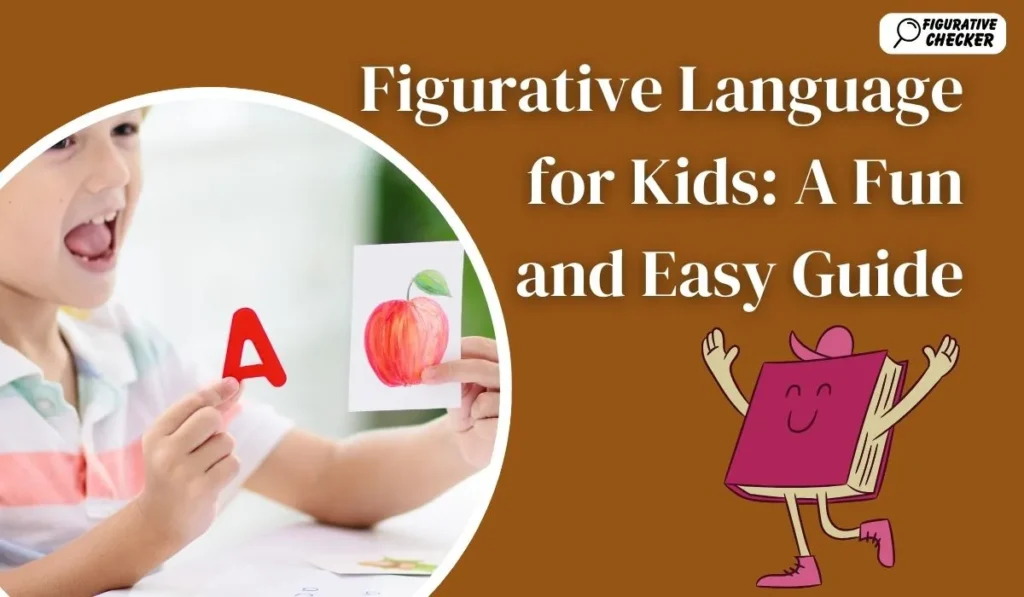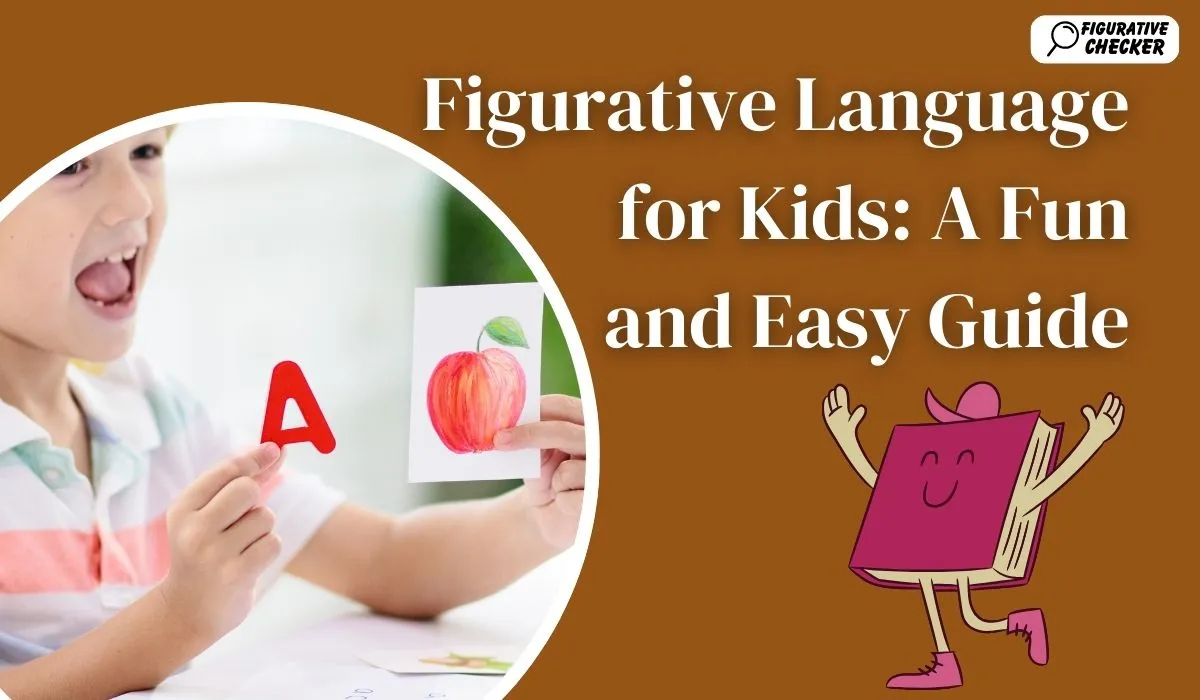Understanding figurative language is essential for kids as it adds color and creativity to communication. It helps young learners express themselves in more engaging ways and understand the deeper meanings of stories and poetry. This comprehensive guide explores various types of figurative language, examples, meanings, and fun ways to learn them.
What is Figurative Language?
Figurative language is when words or phrases go beyond their literal meanings to convey more vivid or imaginative ideas. It’s like a magical tool that makes writing and speech more exciting and memorable.

Types of Figurative Language for Kids
1. Simile
A simile compares two different things using the words “like” or “as.”
- Example: “She is as brave as a lion.”
- Meaning: This means the girl is very courageous.
2. Metaphor
A metaphor also compares two different things but without using “like” or “as.”
- Example: “Time is a thief.”
- Meaning: Time is being compared to a thief because it seems to steal moments from our lives.
3. Personification
Personification gives human qualities to animals, objects, or ideas.
- Example: “The wind whispered through the trees.”
- Meaning: The wind is described as if it can whisper like a person.
4. Hyperbole
Hyperbole is an exaggerated statement not meant to be taken literally.
- Example: “I’m so hungry I could eat a horse.”
- Meaning: This just means the person is very hungry.
5. Onomatopoeia
Onomatopoeia uses words that imitate sounds.
- Example: “The bees buzzed in the garden.”
- Meaning: The word “buzzed” mimics the sound bees make.
6. Alliteration
Alliteration is the repetition of the same sound at the beginning of words.
- Example: “Sally sells seashells by the seashore.”
- Meaning: This phrase repeats the “s” sound to create a catchy rhythm.
7. Idioms
Idioms are phrases with meanings that cannot be understood just by looking at the individual words.
- Example: “It’s raining cats and dogs.”
- Meaning: This means it’s raining heavily.
8. Oxymoron
An oxymoron combines two opposite words for a dramatic effect.
- Example: “Jumbo shrimp.”
- Meaning: The phrase combines “jumbo” (large) and “shrimp” (small), creating an interesting contradiction.
9. Pun
A pun is a humorous play on words.
- Example: “I’m reading a book about anti-gravity; it’s impossible to put down.”
- Meaning: This joke plays on the double meaning of “put down.”
10. Imagery
Imagery uses descriptive language to create vivid pictures in the reader’s mind.
- Example: “The golden sun dipped below the horizon, painting the sky with hues of orange and pink.”
- Meaning: This sentence creates a beautiful image of a sunset.
Why is Figurative Language Important for Kids?
Figurative language is important for kids for several reasons, as it helps them develop both their language skills and their understanding of the world around them. Here are some key reasons why figurative language is crucial for children:
Enhances Creativity and Imagination:
Figurative language, such as metaphors, similes, and personification, encourages kids to think beyond the literal meaning of words. This fosters creativity and helps them express their thoughts and feelings in more vivid and imaginative ways.
Studies have shown that exposure to figurative language improves creative thinking and cognitive flexibility in children (Gernsbacher et al., 2001).
Improves Comprehension and Critical Thinking:
Understanding figurative language helps children develop better comprehension skills. They learn to interpret and understand non-literal meanings in stories, advertisements, and everyday conversations. It also sharpens their critical thinking abilities as they analyze how words and phrases are used to convey deeper meanings.
Research has found that children who engage with figurative language in reading show improved comprehension and interpretive skills (Wolf & Barzillai, 2009).
Boosts Emotional Understanding:
Figurative language allows kids to express emotions and experiences in ways that might be hard to do with literal language alone. For example, saying “I’m feeling on top of the world” can convey a sense of happiness and accomplishment, which is easier to understand than just saying “I’m happy.”
Exposure to figurative language has been linked to increased emotional intelligence in children, as it helps them understand and express their emotions better (Norris M. Haynes, 2013).
Increases Vocabulary:
Figurative language introduces children to new words and phrases. By learning similes, metaphors, and idioms, kids expand their vocabulary and become more confident in using words creatively.
Research shows that children who regularly engage with figurative language in both reading and conversation develop a broader vocabulary (Snow, 2010).
Cultural Understanding:
Many idioms and expressions are deeply rooted in culture. Understanding figurative language helps children connect with different cultures, traditions, and ways of thinking, especially when they encounter these phrases in literature or conversations.
Understanding figurative language can improve cultural literacy and understanding, which is vital in a multicultural society (Pereira, 2011).
Fun Activities to Learn Figurative Language
1. Figurative Language Bingo
Create bingo cards with different types of figurative language. As kids read stories or poems, they mark off examples.
2. Metaphor and Simile Hunt
Ask kids to find similes and metaphors in their favorite books and share them with the class.
3. Illustrate Personification
Have kids draw pictures that represent personification, such as a smiling sun or dancing leaves.
4. Create a Figurative Language Booklet
Each page can feature a type of figurative language with a definition and original example.
5. Onomatopoeia Sound Game
Ask kids to make sounds that match onomatopoeic words like “bang,” “pop,” or “hiss.”
Printable Figurative Language Worksheets
Worksheets are an excellent way to practice figurative language. Below are some ideas for what these worksheets can include:
- Matching Games: Match the type of figurative language to its example.
- Fill-in-the-Blanks: Complete sentences using appropriate figurative language.
- Creative Writing Prompts: Write a short story or poem using at least three types of figurative language.
Examples of Figurative Language for Kids
Short Story Example
Once upon a time, the moon danced joyfully in the night sky. Stars winked at the sleepy town below. The cold wind wrapped its arms around the houses, and the trees whispered secrets to each other. As the morning approached, the sun yawned and stretched its golden arms across the sky.
- Simile: As bright as the sun
- Personification: The sun yawned
- Imagery: Golden arms across the sky
How Parents and Teachers Can Help
- Reading Together: Point out figurative language in books.
- Storytime Discussions: Ask kids how figurative language adds to the story.
- Encourage Writing: Have kids use figurative language in their creative writing.
- Praise Creativity: Reward kids for using imaginative language.
Frequently Asked Questions
Q1: What is figurative language for kids?
Figurative language uses words in creative ways to express ideas or create vivid images. It makes reading and writing more fun and engaging.
Q2: Why is figurative language important?
It helps kids develop better reading comprehension, writing skills, and creative expression.
Q3: Can you give an example of a simile?
Yes! “Her laugh is like a bell ringing on a sunny day.” This compares her laugh to a pleasant sound using “like.”
Q4: Are there worksheets for learning a figurative language?
Absolutely! There are many printable figurative language worksheets available online to help kids practice.
Q5: How can I make learning figurative language fun for my child?
Use games, creative writing challenges, and engaging worksheets to make the learning process enjoyable.
Conclusion
Figurative language adds fun and creativity to communication, making stories and conversations more enjoyable. By learning similes, metaphors, idioms, and other types, kids can develop a love for language that lasts a lifetime. With engaging activities, printable worksheets, and meaningful examples, kids will soon become figurative language experts.
Download a Figurative Language for Kids PDF to keep this guide handy and explore exciting worksheets that make learning fun!
